Top 8 Reasons to Start Using Google’s Business Messages

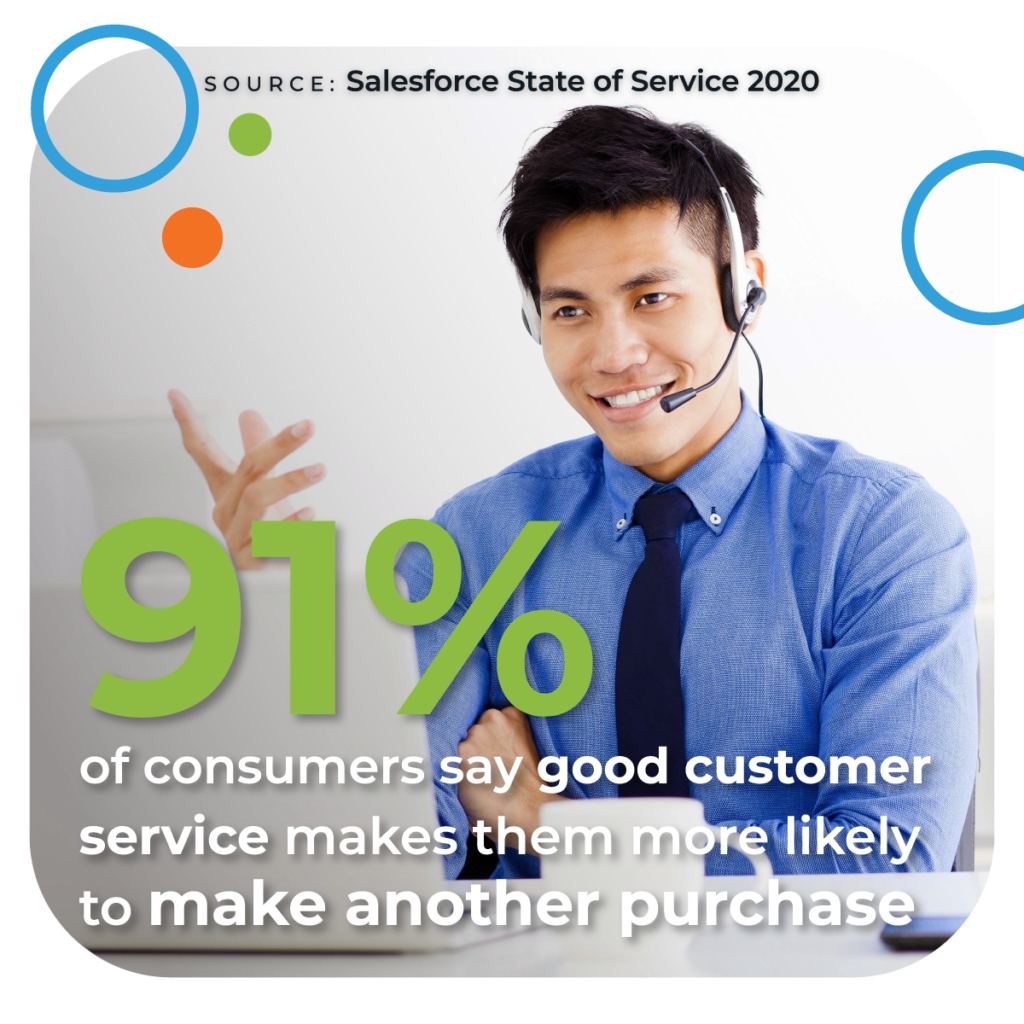 Walking into a brick-and-mortar store and speaking with a sales or customer service associate or picking up the phone and dialing an 800 number were once the primary ways consumers communicated with brands and got pre- and post-sale service. But that’s no longer the case.
Walking into a brick-and-mortar store and speaking with a sales or customer service associate or picking up the phone and dialing an 800 number were once the primary ways consumers communicated with brands and got pre- and post-sale service. But that’s no longer the case.
Today, consumers seek out service via a variety of different channels – from email and phone to messaging apps and social media – and everything in between. And they expect great service, regardless of channel. Brands that deliver are rewarded. According to Salesforce research, 91% of consumers indicate that good customer service makes them more likely to make another purchase in the future.
Increasingly, consumers prefer interacting with brands via digital channels – a trend that’s become even more apparent in the midst of the ongoing pandemic. Forrester predicted that digital customer service interactions would increase by 40% this year. And according to Salesforce’s State of Service report, 87% of service professionals indicate customers have increased their use of digital channels during the pandemic.
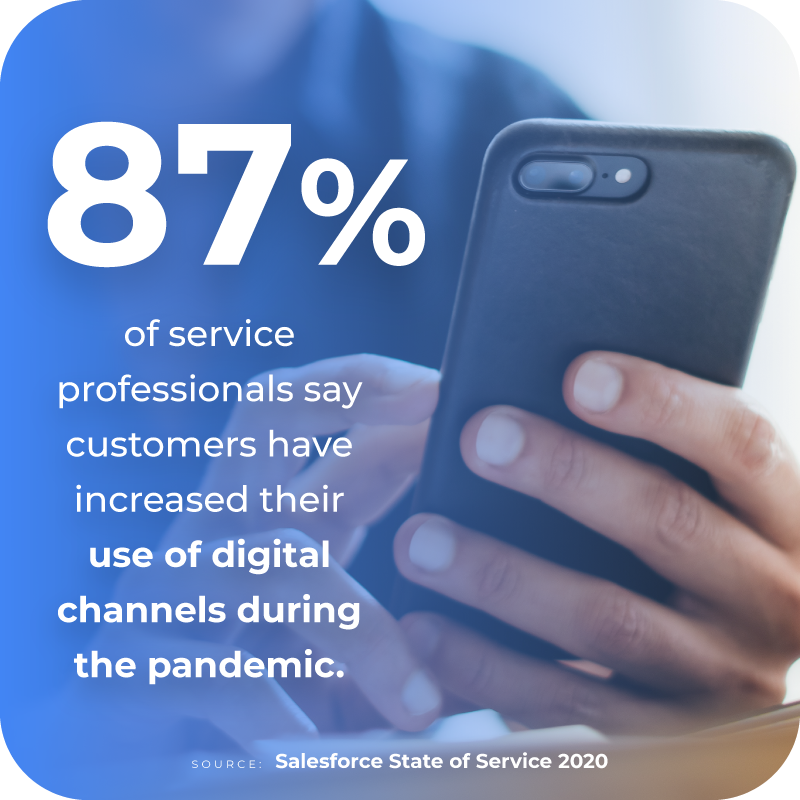 There’s one particular digital channel that’s gaining favor among consumers: messaging services. Here at 1440, we know how important it is for brands to connect with consumers via their preferred channels. And that’s why we’re excited to integrate with Google’s Business Messages.
There’s one particular digital channel that’s gaining favor among consumers: messaging services. Here at 1440, we know how important it is for brands to connect with consumers via their preferred channels. And that’s why we’re excited to integrate with Google’s Business Messages.
Read on to learn what Business Messages is – and some of the top reasons your brand should start using it.
What is Business Messages?
Today, more than ever, consumers rely on messaging apps – such as WhatsApp and Facebook Messenger, among others – to keep in touch with family and friends. In fact, nearly 91% of worldwide internet users turn to chat or messenger apps.
Increasingly, these consumers want to be able to interact with brands in the same way – through messaging. The good news is, Google’s Business Messages lets consumers message businesses, directly from Search and Maps.
 For example, let’s say a consumer is searching for a specific toy on their child’s holiday wish list. They want to know if a store has the toy in stock before making the trip. The consumer navigates to Google to do a search for the store, and a “chat” icon appears in the search results, allowing the consumer to send a message to the brand – and get a real-time response. They find out that the store does indeed carry the toy, and the brand has even put one aside for the shopper to pick up.
For example, let’s say a consumer is searching for a specific toy on their child’s holiday wish list. They want to know if a store has the toy in stock before making the trip. The consumer navigates to Google to do a search for the store, and a “chat” icon appears in the search results, allowing the consumer to send a message to the brand – and get a real-time response. They find out that the store does indeed carry the toy, and the brand has even put one aside for the shopper to pick up.
8 Reasons to Start Using Google’s Business Messages
Traditional communication channels can be frustrating for consumers and brands alike. And a growing number of shoppers prefer to communicate with brands via messaging.
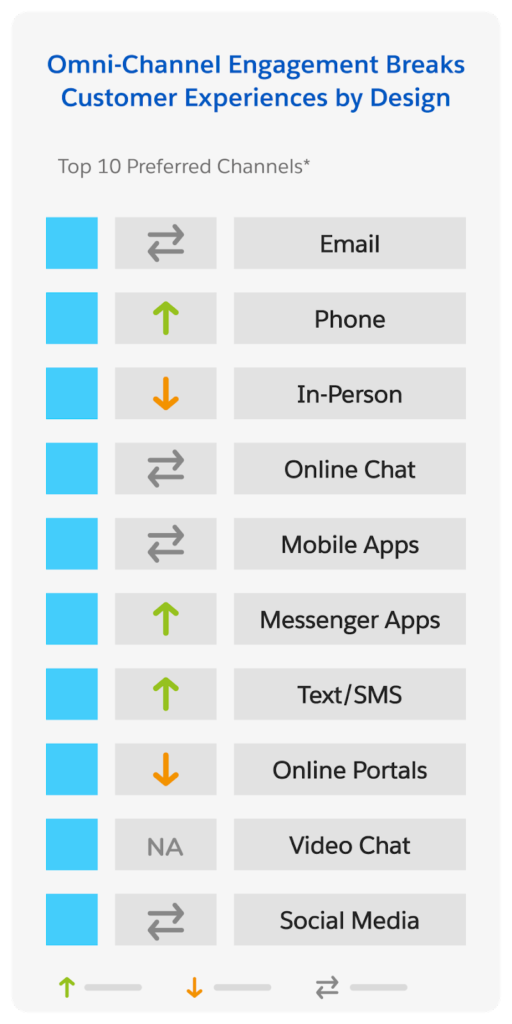 Read on to explore some of the top reasons brands should start using Google’s Business Messages to connect with shoppers in the moments that matter most.
Read on to explore some of the top reasons brands should start using Google’s Business Messages to connect with shoppers in the moments that matter most.
1. Connect with Consumers in their Preferred Medium
Consumers use messaging apps to keep in touch with their family and friends. So it’s probably not surprising that many want to communicate with brands in the same way.
In fact, nearly all (89%) of consumers want to be able to use messaging to communicate with a business. What’s more, many prefer it to other communication channels. Salesforce’s State of the Connected Consumer tells us messaging is quickly climbing the list of consumers’ preferred communication channels – up two positions year over year.
However, less than half of brands are equipped to connect with consumers via messaging. And that means there are a lot of frustrated consumers.
Customer-centric brands must be equipped to engage with consumers via messaging. With Google’s Business Messages, brands can better meet (and exceed) customer expectations by communicating with them through their preferred channel.
2. Meet Consumers Where They Already Are: On Google
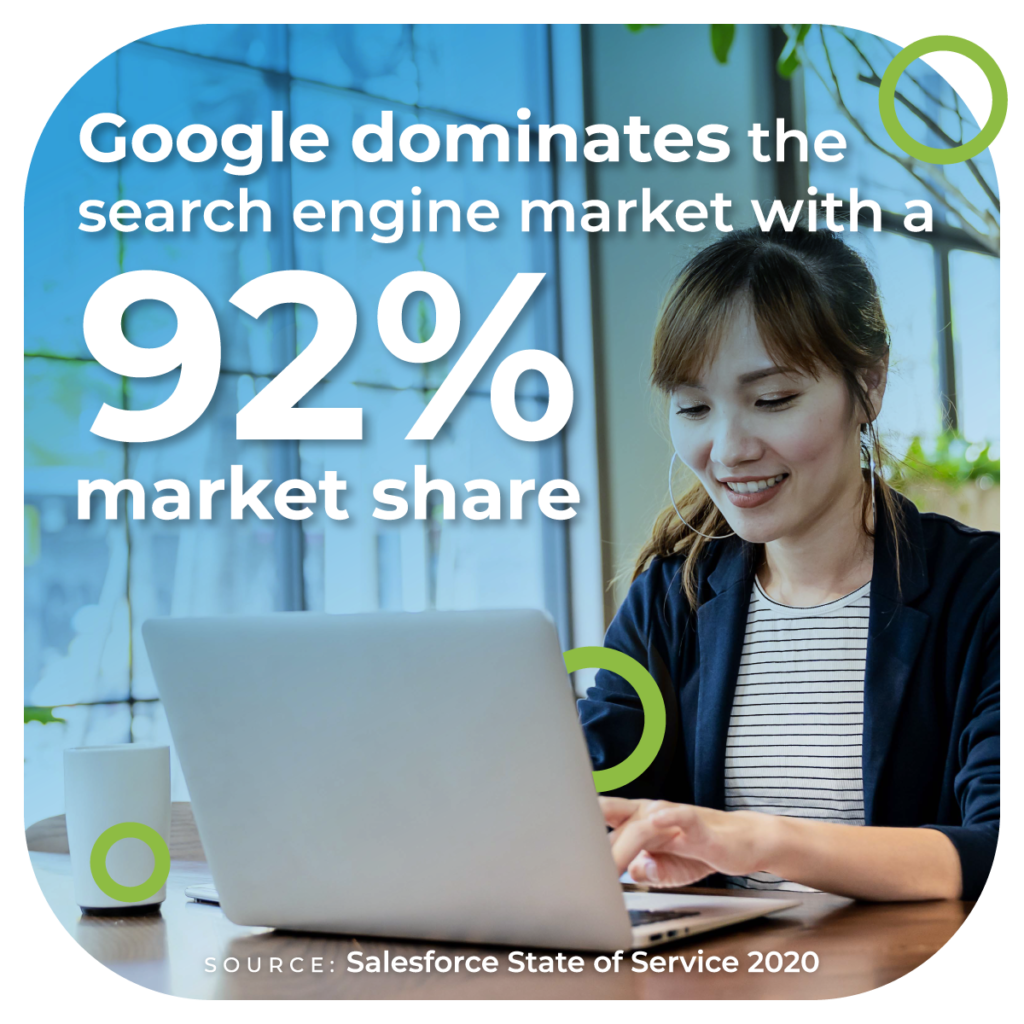 The vast majority of people turn to Google when they want to know something, go somewhere, buy something or get help. So it probably comes as no surprise that there are more than 5.5 billion Google searches worldwide every single day.
The vast majority of people turn to Google when they want to know something, go somewhere, buy something or get help. So it probably comes as no surprise that there are more than 5.5 billion Google searches worldwide every single day.
Oftentimes, consumers turn to Google specifically to find a business’ contact information. And according to Google, some of the top reasons for doing so are to:
- Get more information about a product or service
- Find out about a new product or service
- Decide what product or service to use
- Purchase or book a product or service
- Request post-sales service
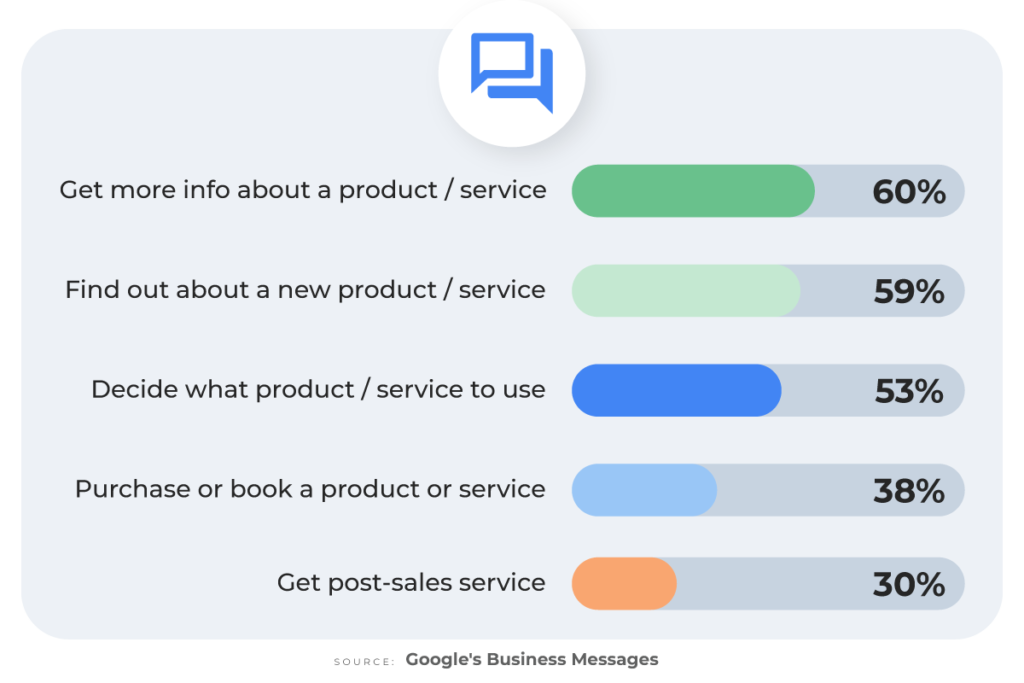
Frequently, the search results drive consumers to make a phone call. But oftentimes, a call simply isn’t the most effective way for brands and consumers to connect. Consumers might avoid making the call, dreading hold times and having to repeat the same question to multiple people. And brands might not have the resources to provide personalized, timely phone service.
But now with Google’s Business Messages, if a consumer searches for a store or brand or tries to find support, they see the option to message the business. That means the consumer gets the information they need, when and where they want it. And the brand has the ability to connect with the consumer where they already are: on Google.
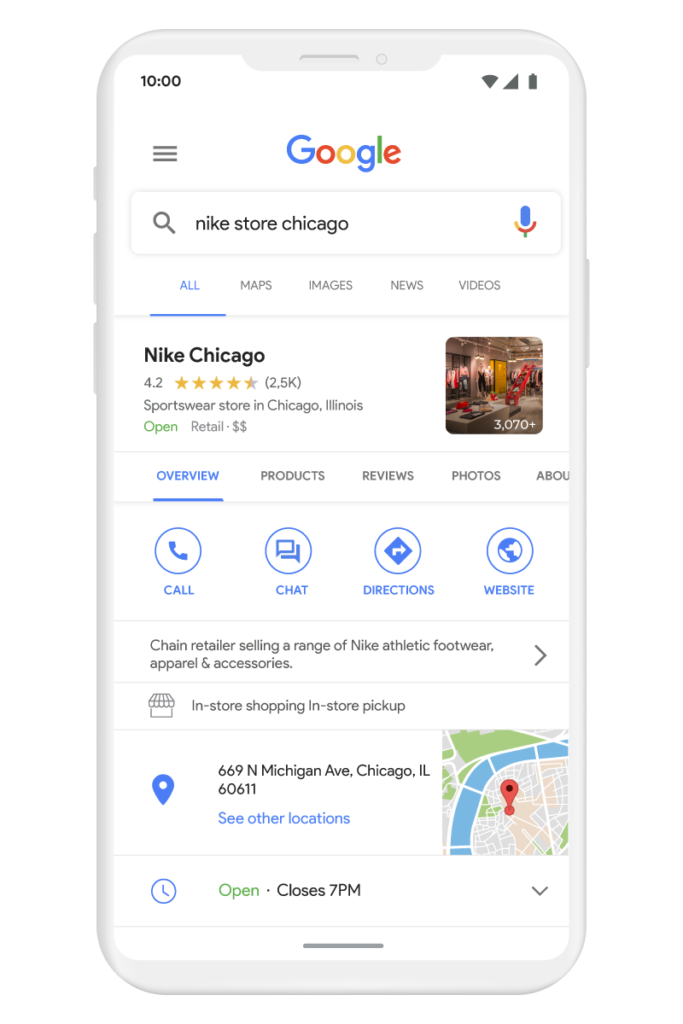
3. Deliver Engaging, Personalized Messaging Experiences
Messaging with a family member or friend is an engaging experience. But oftentimes, that’s not the case when a consumer communicates with a brand. Oftentimes, such communications are limited to text and the occasional link. For example, let’s say a consumer sends a Facebook message to a brand, asking about their top-selling toys for a five-year-old. The brand might respond with some text, as well as a link to a landing page.
However, Google’s Business Messages allow brands to deliver engaging, personalized messaging experiences to shoppers – right on Google. For a consumer, using Business Messages provides a similar experience to messaging with a friend with features like a typing indicator and quick reply options. What’s more, Business Messaging supports image carousels, videos, and other visual media that makes messaging even more engaging. So if that same shopper reached out to a brand about toys, the brand could reply with a shoppable carousel of the latest and greatest toys for five-year-olds.
4. Cut Down on Wait Times and Interact with Consumers in Real-Time
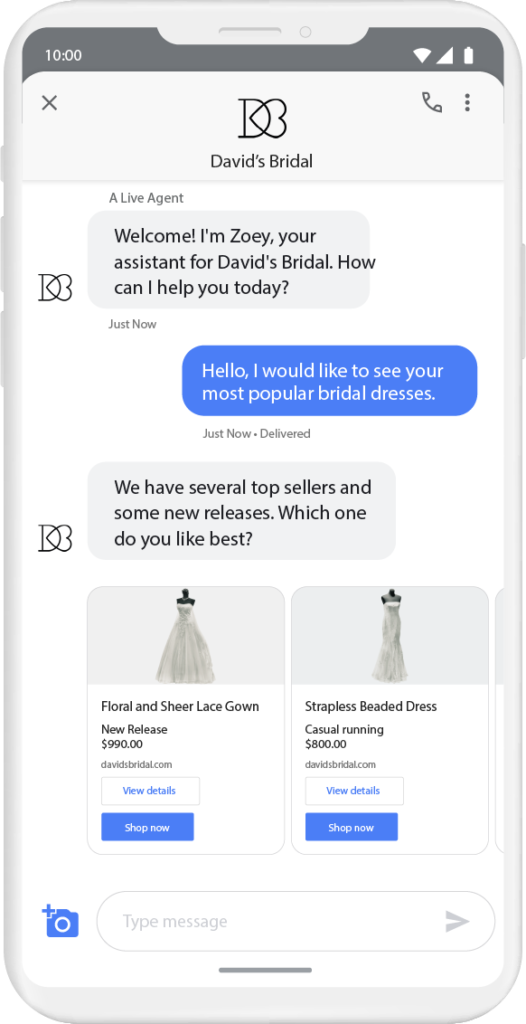 Traditional communication methods can be frustrating for consumers. One of the biggest frustrations? Wait times.
Traditional communication methods can be frustrating for consumers. One of the biggest frustrations? Wait times.
According to Google, four in 10 consumers are frustrated by being stuck on hold for too long. There’s just nothing quite as enraging as having to listen to the same elevator music on repeat!
Of course, email is an option. But customer service agents can only respond to one email at a time. And that means consumers who contact a business via email might have to wait hours or even days for a response.
But with Business Messages, brands can drastically cut down on wait times and interact with consumers in real-time. In fact, four in 10 businesses say messaging will help reduce customer wait times.
Brands can set up chatbots to answer common questions and resolve simple issues – which helps consumers get immediate answers. Plus, a brand’s customer service agents can more easily juggle multiple messages than they can multiple phone calls, which means speedier responses. And of course, faster answers boost customer satisfaction.
5. Own and Foster Customer Relationships
Marketing channels that were once effective ways to engage customers are slowly eroding. Email open rates drop year over year. Cookies will be gone in 2023. And social media channels are essentially rented collections of customers that can be marketed to by the highest bidder.
However, Google’s Business Messages empowers brands to own their relationships and conversations with consumers – and foster those relationships long-term.
Brands earn consumer trust by serving them at their moment of need. And when consumers trust brands, they’re more willing to provide information such as email addresses or social media handles. This is a unique opportunity to collect first-party data – and then use that data to provide even better, more personalized customer experiences.
6. Protect Consumers’ Privacy
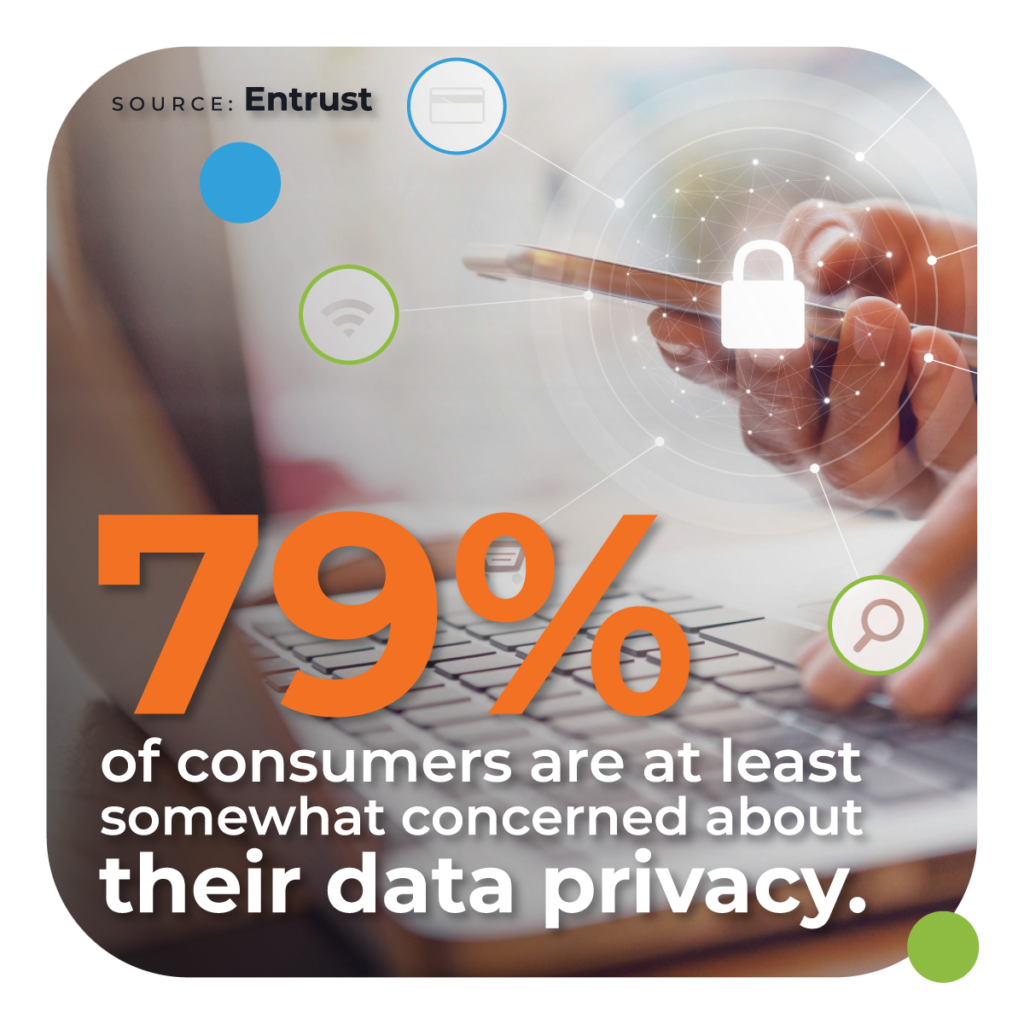 Concerns over data privacy are growing. According to Entrust, 79% of consumers are at least somewhat concerned about their data privacy.
Concerns over data privacy are growing. According to Entrust, 79% of consumers are at least somewhat concerned about their data privacy.
Though consumers prefer messaging, they may hesitate to contact a brand through this channel, not knowing whether they’re really contacting the brand or if their information is safe.
According to Google, a top messaging benefit sought by consumers is peace of mind that conversations are secure. Business Messaging offers that peace of mind.
Google is a name consumers know and trust. What’s more, Google’s Business Messages has robust security and privacy features so consumers can reach out with confidence – and get quick answers to their questions.
7. Gain 360 Degree Views Of Your Customers That Power Personalized Experiences
Modern consumers expect personalized experiences throughout the purchase journey. But each consumer is different. In order to deliver personalized experiences, brands must have a single, 360 view of each customer.
Google’s Business Messages provides brands with a platform to support consumer conversations that are powered by Salesforce Clouds and data. Within a conversation, a lead can be created, a case can be opened, a knowledge article shared, and an order can be placed (or canceled). Each of these journeys can be measured and attributed back to the original customer. This helps brands gain a 360 view of the customer – which then empowers the brand to deliver better, more personalized customer experiences.
8. Access Insights to Improve Products and Experiences
Consumers today have more choices than ever before. And they won’t hesitate to leave a brand if something better comes along.
In order to survive and thrive, brands must embrace customer feedback – and use that feedback to optimize products and experiences. Conversations via Google’s Business Messages are a great source of such feedback.
Brands can look for themes in the conversations they have through Business Messages. For example, a shoe retailer might notice a lot of consumers using Business Messages specifically asking about sizing. This could be an opportunity for the brand to add some additional tools and information to product pages to help shoppers pick the right size.
Start Engaging with Shoppers in the Moments that Matter with Google’s Business Messages
Traditional communication methods are frustrating for brands and consumers alike. And increasingly, consumers want to be able to communicate with brands via messaging.
Google’s Business Messages empowers brands to connect with consumers in the moments that matter. Messaging Studio by 1440 can help those same brands power digital conversations on Google Business Messages and other channels with a single hub in Salesforce.